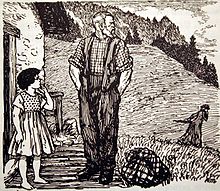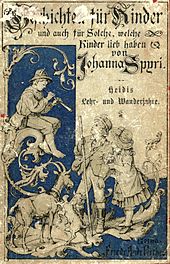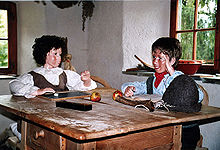Heidi (novel)
The two children 's books Heidi's Lehr- und Wanderjahre and Heidi can use what she learned from the Swiss author Johanna Spyri (1827–1901) from 1880 and 1881 are among the most famous children's books in the world. With her Heidi books, Johanna Spyri created a romantic and ideal image of Switzerland that is still widespread today .
Books
«Heidi's apprenticeship and wandering years»

Where in 1880 the publishing house of Friedrich Andreas Perthes , Gotha first published Heidi novel is told how the orphan girl Heidi to his reclusive grandfather (Alpöhi or Almöhi, depending on the version) on an alp above Maienfeld in the canton of Grisons is brought where to live in the future. Heidi's aunt Dete had previously been in charge after Heidi's mother died. Dete takes her to the Alpöhi before she takes a job as a maid in Frankfurt am Main . The Alpöhi is not very enthusiastic at first, but takes care of Heidi from the start. He quickly gets used to her and soon notices that the bright, enterprising girl makes his life more pleasant. Even before she arrives on the alp, she meets Peter the goat, an eleven-year-old goatherd, with whom she hikes regularly to the high alpine pastures where the goats from the village graze. She especially enjoys the rustling of the fir trees behind her grandfather's hut.
Heidi also gets to know Geissenpeter's blind grandmother and gets the Alpöhi to repair their dilapidated house. However, despite persuasion by the village pastor, he refuses to send Heidi to school because he would have had to move to the village in the winter months. However, three years after Heidi's arrival, when she was eight, Heidi's aunt Dete appeared and took the girl to Frankfurt am Main, where she was to become the companion of the paralyzed Klara Sesemann. Klara quickly accepts Heidi as her new friend. Only the housekeeper, Miss Rottenmeier, is not enthusiastic. Above all, she is horrified when she learns that Heidi cannot read. Klara's grandmother manages to convince Heidi to learn to read.
However, Heidi feels worse and worse in the Sesemann house, she longs for the mountains. Klara's grandmother teaches Heidi that she can always receive consolation in prayer to God. Heidi begins to sleepwalk from homesickness . Herr Sesemann and his doctor decide to send Heidi back to the mountains, and Heidi is put on the train home, accompanied by the servant Sebastian. When Heidi returns to the Alpöhi, he is so happy that he visits the church in the Dörfli for the first time in decades, which the villagers are both amazed and delighted with. He promises the pastor to spend the winter in the Dörfli from now on so that Heidi can go to school there.
"Heidi can use what she has learned"
Klara would like to visit Heidi in the same autumn on the alp, but the doctor urgently advises against it because her health has deteriorated since Heidi's parting. Instead, he travels to the Alp himself to clarify the situation, and is welcomed there by Heidi. The doctor also gets along very well with the Alpöhi, but has to return to Frankfurt.
As promised, the Alpöhi spends the winter in a crumbling mansion in Dörfli, which he has previously repaired. Heidi uses gentle pressure to get Peter to learn to read as well. The following summer, Klara was allowed to go to the Alpöhi hut after a spa stay in Bad Ragaz . She is quartered in the hayloft where Heidi slept for so many years. Peter, who is jealous because Klara is now claiming Heidi's full attention, is not very enthusiastic.
One day Heidi wants to take Klara to the alpine pastures with Alpöhi's help. Peter is enraged about it out of jealousy. So - when nobody sees it - he lets Klara’s wheelchair, provided by the Alpöhi, roll into the depths so that it shatters. The Alpöhi cannot be dissuaded from the project and carries Klara up the alpine pasture. There Klara learns to walk with the support of Heidi and Peter, after she has already done her first walking exercises with the Alpöhi. There is a big surprise for grandmother and a few hours later for father Sesemann when they come to visit: Klara walks towards her father on her own two feet. Mr. Sesemann and later the doctor promise the Alpöhi to take care of Heidi if he is no longer able to do so.
Main characters in the Heidi novels
The names were spelled differently by Johanna Spyri in the original first edition than is usual today.
Heidi
Heidi, named Adelheid , is a girl who, as an orphan, is not spoiled by fate, but is rewarded with a happy ending . At the beginning of the first volume, Heidi is five years old, at the end of the second volume she must be around nine.
Goat peter
The goat Peter (in some adaptations also called goat peter ) is a ten-year-old rascal who tends the goats ( goats ) of the village and does not like to go to school because he does not succeed in learning to read at first and he thinks that he does not at all need. He lives with his mother Brigitte and his blind grandmother in a hut halfway between the Dörfli and the Alpöhi hut. Alpöhi usually calls him goat general. Although he is taciturn and jealous, he is Heidi's best friend.
Alpöhi, the grandfather

The Alpöhi (called “Alm-Öhi” in the High German first edition) lives as a hermit in his hut. His granddaughter Heidi brings him closer to the people from whom he had withdrawn in anger. In his youth in Domleschg he gambled away the family inheritance and gave it away . He moved to Naples and served in the military . Rumor has it that he killed someone there and had to desert . Later he returned with his son Tobias and settled in the Dörfli . Tobias was killed in an accident at work; his weak wife Adelheid died of grief a short time later, so that her sister Dete had to look after little Heidi for four years. The name Alpöhi literally means Alm- Uncle , i.e. Almonkel.
Klara Sesemann
Klara is a handicapped girl, around twelve years old, from a rich family. She grew up motherless in Frankfurt. The father is constantly on the move and has little time for his daughter. With the help of Heidi, Klara is first freed from her loneliness and later from her suffering.
Mr. Sesemann
Mr. Sesemann, Klara's father, is a businessman and often out and about, partly because he cannot bear the sight of his paralyzed daughter and cannot get over the loss of his wife. Together with the doctor, he suggests letting Heidi go back to the mountains.
Mrs. Sesemann
Ms. Sesemann, the warm-hearted mother of Klara's father, visits Frankfurt at irregular intervals. It brings some variety to the monotonous life. With the help of an illustrated book, she gets Heidi to read.
Miss Rottenmeier
The elderly maid runs the household for the widowed Mr. Sesemann and his daughter. She doesn't make it easy for Heidi because she doesn't understand the girl. She is of the opinion that Heidi is wild and must be brought up strictly.
Kinship relationships
The family relationships, as she tells Dete on the ascent to the alp, are as follows:
- Heidi is the daughter of Adelheid and Tobias.
- Tobias is the son of Alpöhi.
- Dete is Adelheid's sister.
- Detes great-grandmother and the grandmother of Alpöhi were siblings.
After the death of Adelheid and Tobias, Dete and her mother recognized the relationship to Heidi.
template
Johanna Spyri was possibly inspired by the story Adelaide - the girl from the Alps by the German teacher and writer Hermann Adam von Kamp for her Heidi novels . However, this thesis is controversial and requires further research.
Derivative works
In just a few years after their first publication, the Heidi books became a global success.
The book first appeared in the United States in a translation by Louise Brooks in 1884. The plot of Frances Hodgson Burnett's novel The Secret Garden (1909), a classic of American children's literature, shows striking parallels to the plot of the first Heidi book on. To date, the Heidi books have been translated into over 50 languages and filmed several times. After the copyrights have expired, more and more Heidi books and stories appear, but some of them no longer have much in common with Spyris Heidi , ranging from linguistic modernizations to sequels or transfers into the present day.
Cartoons
- 1991: Heidi, Japan, alternatively: Sugar & Spice: Heidi, USA
- 1993: Heidi - childhood in the mountains, Japan, 88 minutes
- 1993: Heidi - A Summer Full of Happiness, Japan, 90 minutes, continuation of "Heidi - Childhood in the Mountains"
- 1995: Heidi, Japan, director: Toshiyuki Hiruma Takashi, 47 min., Film
- 1998: Heidi, Germany, Switzerland, director: Alain Gsponer , 3 min. Short animation film on Swiss image advertising
- 2002: Heidi, Germany, directed by Albert Hanan Kaminski
- 2005: Heidi, Great Britain, Germany, 81 min.
- 2015: Heidi , France, Australia, Germany, Belgium
cinemamovies
- 1920: Heidi , USA, silent film, director: Frederick A. Thomson
- 1937: Heidi , USA, free novel adaptation
- 1952: Heidi , CH, free adaptation, but close to the novel, first German-language Heidi film
- 1953: Heidi and her friends , D, adaptation not following the novel with some Heidi motifs
- 1955: Heidi and Peter , CH, continuation of Heidi (1952) freely based on the 2nd Heidi volume
- 1965: Heidi , A, remake in color of the black and white film from 1952
- 1968: Heidi returns home USA / D, 96 minutes, with Maximilian Schell , Jean Simmons , Jennifer Edwards
- 1993: Heidi , USA / A / LUX, free novel adaptation
- 2001: Heidi , CH, adaptation not following the novel, Heidi is now set in the 21st century
- 2005: Heidi , GB, 104 min, director: Paul Marcus, with Emma Bolger (Heidi), Max von Sydow (Alp-Oehi), Sam Friend (Geissenpeter), Geraldine Chaplin (Miss Rottenmeier), Jessica Claridge (Klara Sesemann), Diana Rigg (Klara's grandmother), Robert Bathurst (Consul Sesemann), Del Synnott (butler Sebastian) and Oliver Ford Davies (Dr. Classen)
- 2015: Heidi , CH / D, director: Alain Gsponer , with Anuk Steffen (Heidi), Peter Lohmeyer (Sebastian), Bruno Ganz (Almöhi), Katharina Schüttler (Miss Rottenmeier), Maxim Mehmet (Mr. Sesemann)
Series
- 1953: Great Britain, six episodes of 30 minutes each.
- 1960: TV series
- 1974: Heidi (1974)
- 1974: Great Britain, six episodes of 30 minutes each, director: June Wyndham-Davies
- 1978: Heidi (1978) , J / D, TV version based very closely on the novels
- 2015: Heidi , F / AUS / D / B, computer-animated series
Television films
- 1978: Die neue Abenteuer von Heidi ( The New Adventures of Heidi ) USA, free novel adaptation, with Burl Ives (Grandfather) and Katy Kurtzman (Heidi)
comics
- 1976–1977: Heidi, 21 booklets, Bastei Verlag
- 1977–1981: Heidi, 179 booklets, Bastei Verlag
- 1978: Heidi , paperback album, Bastei Verlag
- 1978–1979: Heidi, eight paperback books, Bastei Verlag
- 1978–1981: Heidi, four paperbacks, Condor Verlag
- 1979: Heidi Comic Special, Issue, Condor Verlag
- 1980–1984: Heidi, nine paperbacks, Bastei Verlag
- 1987–1988: Heidi, 28 booklets, Bastei Verlag
Musicals
-
Heidi - Das Musical (2005 Switzerland / Great Britain), musical by Shaun McKenna (text) and Stephen Keeling (music), based on an idea by Stefan Mens .
The processing of the material connects the Heidi book with the life story of Johanna Spyri. While Johanna Spyri is fighting for the life of her son Bernhard, she meets her own character in a novel. The musical had itsworld premiereon July 23, 2005 in Walenstadt (Switzerland) and was performed on an open-air stage (part 2 2007) - 2005: Heidi… a mountain musical (book: Christian Berg , music: Stephan Sulke ) performed in 2018 on the Hallenberg open-air stage
- 2006: Freilichtbühne Coesfeld , musical by Claus Martin
In contrast to the arrangement by McKenna / Keeling, Martin sticks closely to Spyri's original. The essential elements from both Heidi novels are condensed into a continuous plot, at the center of which is the "passive heroine" Heidi. The music consists largely of catchy pop numbers. - 2012: Heidi - The musical for children by Andrew Bond
- 2018: Heidi , musical by Michael Schanze
- 2019: Heidi - stronger than ever , musical by Norberto Bertassi and Norbert Holoubek
Heidi in other cultures
Japan
Heidi has been widely received in Japan .
Turkey
In Turkey belongs Heidi the most important children's books at all.
Philatelic
With the Inception 5 December 2019 which gave German Post AG in the series childhood heroes a postage stamp (and date stamp ) in nominal value out of 60 euro cents with the image of Heidi. The design comes from the graphic designer Jennifer Dengler from Bonn.
advertising
Heidi's name and figure are used again and again for advertising purposes. Peter Steiner incarnated in 1993 as Milka - advertising figure the "Alpöhi". The area in which the story of Heidi took place has been marketed under the name " Heidiland Holiday Region " since 1997 . The hamlet of Grevaselvas in the Engadine is also marketed as a "Heidi village" because a Heidi television series was filmed there in 1978.
literature
- Viceversa Literature , Yearbook 10, Rotpunktverlag, 2016, main topic "Heidi"
See also
Web links
![]() Heidi public domain audio book at LibriVox
Heidi public domain audio book at LibriVox
- First edition from 1880, doi: 10.3931 / e-rara-16704
- The romantic text in the Gutenberg-DE project
- The text of the first edition in the preserved original spelling. In: Bibliotheca Augustana
- Heidi (1974, cartoon series) on Fernsehserien.de
- Did Heidi's father come from Mülheim? In: muelheim-ruhr.de, February 15, 2016 (Contribution by the Mülheim City Archives to the plagiarism debate about Heidi)
Individual evidence
- ↑ Rosmarie Zeller: Heidi. In: Historical Lexicon of Switzerland . June 25, 2006 , accessed September 18, 2020 .
- ^ Project Gutenbergs eBook, Heidi's Lehr- und Wanderjahre. In: gutenberg.org. Project Gutenberg , accessed October 3, 2019 .
- ↑ First edition. In: hs-augsburg.de. Bibliotheca Augustana, accessed October 3, 2019.
- ↑ Thorsten Stecher: Ur-Heidi from the Ruhr area. Has Johanna Spyri's Alpine history been stolen? (Not available online.) In: 3sat.de . April 7, 2010, archived from the original on July 30, 2012 ; accessed on September 25, 2018 . See also Shattered Myth. Heidi, the mountain creature, was invented in Germany. « Kulturplatz » broadcast. (No longer available online.) In: SF . April 7, 2010, archived from the original on March 3, 2014 ; accessed on September 25, 2018 (video no longer available).
- ↑ Sieglinde Geisel: The fairy tale of the Ur-Heidi. In: NZZ Online . April 15, 2010, accessed October 3, 2019.
- ↑ Susan Stan: Heidi in English . A Bibliographic Study. In: New Review of Children's Literature and Librarianship . tape 16 , no. 1 , July 27, 2010, ISSN 1361-4541 , p. 1–23 , doi : 10.1080 / 13614541.2010.495568 (English, tandfonline.com [PDF; 502 kB ; accessed on October 3, 2019]).
- ↑ Jerry Griswold: “Heidi” & “The Secret Garden”. In: medium.com. November 14, 2016, accessed October 2, 2019 .
- ↑ Heidi ... a mountain musical. (No longer available online.) In: meiselmusicshop.de. Musikverlag Meisel, archived from the original on December 18, 2016 ; accessed on October 3, 2019 (no mementos). Info: The archive link was inserted automatically and has not yet been checked. Please check the original and archive link according to the instructions and then remove this notice. .
- ^ Kurier.at
- ↑ Series "Childhood Heroes". Heidi and Pippi Longstocking. Federal Ministry of Finance , December 5, 2019, accessed on December 5, 2019 (with illustration).



